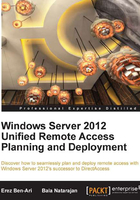
A child could do it! (well...almost)
When designing Unified Remote Access, Microsoft realized that not all organizations can meet the complex requirements that DirectAccess imposed. For example, with DirectAccess, you had to assign two consecutive public IP addresses to the server, and these IPs could not be NAT addresses. You also needed to set up a digital certificate infrastructure and assign certificates to all computers that would use DirectAccess. These imposed a steep learning curve that deterred many administrators from even looking into this technology, let alone successfully implementing it. Windows Server 2012 Unified Remote Access makes things a lot simpler by allowing you to host the server behind a NAT firewall, and using a component called KerbProxy to provide tight security even without certificates.
Other changes to the technology are about making life easier for everyone. Before Windows Server 2012, client computers needed to be brought onto the corporate network to receive the Group Policy update which configured them for the connection. Now, that is no longer needed and the computer can be configured wherever it is. Another enhancement to the user experience is the integration of a special piece of software called the Network Connectivity Assistant (NCA) into Windows 8. The NCA provides the user with the information about the connection, making things easier to handle if there's a problem. The NCA is similar to the DirectAccess Connectivity Assistant (DCA) that was used with earlier incarnations of DirectAccess. The DCA was a separate optional install, but NCA comes with Windows 8, making things easier for everyone:
